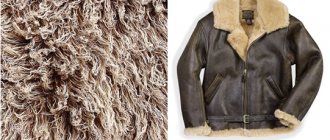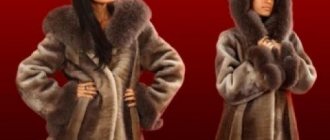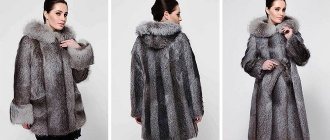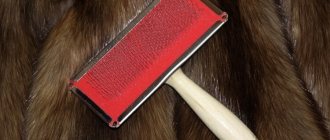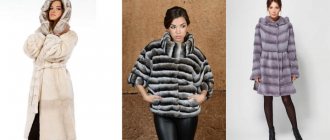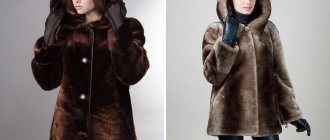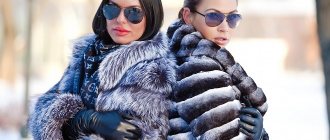What is the difference between mouton coats and tiger coats?
Both mouton and tsigeika are essentially sheepskin, but there is a significant difference between them.
Tsigei fur products were made from shorn and dyed fur from sheep of a special breed - Tsigei. Currently, this breed is no longer bred in Russia and imported raw materials are used for sewing outerwear - sheep skins grown in Australia, Mongolia, China and other countries. Mouton, a word translated from French as “ram,” is sheepskin processed in a special way, and since the technology involves the use of formaldehyde, this method is considered harmful and is not used anywhere except in Russia. For the production of mouton, the skins of only certain breeds of sheep grown in Australia and New Zealand are also used. They are distinguished by high thermal insulation properties and super strength, and after processing these qualities are not lost, but only enhanced.
Otter fur is considered the most durable; a fur coat made from it will last about 20 years; a beaver or mouton fur coat will last 18 years, sable - 12 years, mink - 10 years.
The processing of these hides includes traditional stages - first they go through the fleshing stage and are cleaned of residual fat and muscle tissue, then the felting stage - they are rotated in a vibrating drum to give the flesh softness. After this, the skins are stretched on a special table so that they become larger in area.
A special technological stage - formaldehyde treatment - turns ordinary sheepskin into a mouton. After this, the fur becomes moisture-resistant and especially durable, and poisonous formaldehyde is specially cleaned and removed from the surface of the skin. The fur is trimmed and smoothed in a special way, after which the mouton takes on its own appearance, and only a specialist can recognize it as ordinary sheepskin.
Mouton is characterized by a high density of pile, it does not pill and retains its presentation even with daily use.
What is the difference between mouton and sheepskin. Mouton and sheepskin: is there a difference?
Mouton - what is it, whose fur is it? Mouton is the name given to sheep skin after certain processing. The fur is cut short and treated with formaldehyde. This substance envelops each hair and makes it resistant to moisture, frost and wind. This technology is currently used only in Russia and China. Therefore, products made from mouton are perfectly suited for the harsh Russian climate. After turning sheepskin into a mouton, the durability of the products increases significantly. Short fur is incredibly soft and pleasant to the touch, it retains heat perfectly even at very low temperatures. In addition, the pile is cut and leveled using imported equipment, and is also often dyed in order to give the product not just a marketable appearance, but to give it the opportunity to enter the category of premium products. In this case, a rich color palette is used, including classic options - snow-white or cream. Thanks to this, the finished product looks very impressive and respectable. The high density of the pile ensures that it will not curl or lose its properties even with intensive daily use. That is why first-class sheep fur is ideal for making car capes, which, in addition to a presentable appearance, also require high wear resistance. The quality of the dressing also allows you to understand how a mouton differs from a sheepskin. Mouton products are lighter, although they cost a little more. They are also easier to care for, since dust penetrates less through the dense pile, and debris does not get stuck between the fluffy piles. To maintain the magnificent appearance of such fur car covers, it is enough to shake them out and vacuum them a couple of times a month. Sheepskin and mouton are natural furs that are directly dependent on each other: without the first, there would be no second. However, not every sheepskin will eventually become a mouton, but only the most first-class!!!
How will a mouton differ from other fur products?
This fur is not afraid of wet snow and wind, it is one of the most durable.
Despite the fact that a mouton coat is much cheaper than a mink coat, in terms of its consumer and decorative qualities, a mouton ranks on a par with expensive elite furs. Thanks to modern technologies, this fur can be dyed in a variety of colors, each product made from it has its own unique shade. The fur is quite dense and tall, very light in weight and comfortable to wear, it can be easily cleaned, but, as a rule, it does not really need this, since it has dirt-repellent properties.
Every woman dreams of a beautiful and warm fur coat? It is in it that she looks especially elegant and attracts the attention of others. A girl dressed in a fashionable down jacket looks more like a teenager, while in a fur coat she looks like a real lady. Therefore, it’s worth finding out how to choose a cygeik fur coat and care for the fur.
What animal are girls interested in today? Statistics show that many women and girls prefer a tan fur coat. Thanks to the amazing qualities of fur and low cost, this product is very popular.
All about the mouton. Is it worth the candle?
Mouton (ennobled sheepskin) was invented, according to one version, by specialists in the German leather and fur industry. This type of fur is much cheaper, for example, mink fur, but the special technology for processing sheepskin allows products made from mouton to stand on a par with expensive furs - and in almost all characteristics.
The word “mouton” is translated from French as “ram” (and France, by the way, is considered by experts as another possible homeland of this method of fur dressing). But “ram”, i.e. sheepskin for the production of mouton, only one type is used. Moreover, animals for the production of refined sheepskin are raised in Australia and New Zealand. The fur of such “mouton” sheep is distinguished by high thermal insulation properties and super strength - this material for fur coats is considered the best in the world. And it is from Australia that skins are brought to Russia for the production of mouton.
"Mouton" sheep
The technology for producing mouton products also has a number of features. After the two stages of primary preparation of the skin for ordinary “sheepskin coats” (fleshing - cleaning from the remains of animal tissue and felting - rotating in a vibrating drum for many hours to give it softness), the third stage necessary for a mouton is followed - stretching the skin on a special table. At the same time, the leather fabric does not lose strength and elasticity. And the large volume of skin area allows sewing to be done with a minimum number of seams, which makes the product more durable and long-lasting. However, the stage of making refined sheepskin does not end here. In Russia, skins prepared in this way are treated with a formaldehyde solution so that the hairs become moisture resistant. And only after this, mouton products will not be afraid of wet snow, temperature changes and other surprises of the Russian winter.
It should be noted that the use of formalin at the initial stages of processing hides does not pose a danger to their future buyers. The fact is that after this treatment, the skins will undergo special cleaning more than once, during which all chemicals will be removed.
Formalin is used to treat sheepskin hides
The treated sheepskin then undergoes a real transformation: the evenly trimmed wool is smoothed in a special way. After this, only production technologists or other fur industry specialists will recognize the sheepskin in the fur “semi-finished product”.
The capabilities of modern fur industry technologies make it possible to dye a mouton (the natural color of which is not very expressive) in deep, bright colors. The color palette is amazing. There is a feeling that each fur coat has its own unique shade. Fur coloring occurs after it has been treated with formaldehyde. Advanced technologies make it possible to make a mouton lightweight with the highest density of fur - and therefore more convenient and comfortable to wear.
What is a sage fur coat?
Until recently, products made from tsigeika were called clothes made from sheep skins. Moreover, only the fur of Tsigai and Merino sheep was used here. The skins undergo special processing and a special dyeing method.
Today the fur industry calls tsigeika a mouton, the products from which are significantly different from those produced several decades ago. Clothes made from this fur have become much lighter and more comfortable. Also, a wide selection of different styles and models has appeared. On sale you can find products made from mouton in various colors and shades, as shown in the photo.
Nowadays, there is almost no such breed of sheep as the Tsigai. Therefore, fur products began to be made from other skins, no less valuable breeds of sheep. Russian fur clothing manufacturers most often purchase raw materials abroad.
Benefits of Tsigeika
- Perhaps the most important advantage of this fur is that it has anti-allergenic properties. It is due to the fact that sheep’s wool does not contain microorganisms that cause this disease in humans;
- Modern tiger fur coats are capable of allowing air to pass through. However, their pile is elastic, so it does not fall off during wear;
- Thanks to new technologies, skins gain strength without losing softness. This allows specialists to create unique fur clothing;
- The fur of the tsigeika is dense enough to keep you warm even in severe cold;
- By caring for a fur product in accordance with all care rules, the fur coat will serve you for more than 10 years and maintain an excellent appearance.
This fur has an affordable price, compared to such expensive furs as mink, arctic fox, sable, etc. If you do not have the opportunity to purchase an expensive product, the best option would be a sage fur coat in the photo, you can see several models.
Rules for choosing fur
You need to choose a fur coat from tsigeika with all responsibility. To do this you need to know a few basic rules. It is important to buy a fur product in a specialized store where you do not risk purchasing a fake. In addition, here you can request documents for the product and a warranty card.
Pay special attention to the quality of the fur, its color and tailoring of the fur coat. You can check the quality of the pile in this way: squeeze the fur coat with your hand and release it after a couple of seconds. The hairs should return to their original shape. High-quality fur will not stick together or break if you run your palm over it against the grain.
Run a white napkin over the fur: there should be no traces of paint left on it. Otherwise, it is better not to buy such a thing. The strength of the pile can be checked by tugging the hairs - they should not come off.
Also check the inside of the chicken coat. The lining must be sewn correctly. There remains an unstitched area at the bottom so that you can check the quality of the prepared flesh. Check the seams well to make sure they are not bulging. A high-quality fur product can only be sewn with threads, and not glued.
Caring for a cige fur coat
The more carefully you treat a fur product, the longer it will keep you warm and look pleasant. Despite the fact that sage fur is durable, it is easily damaged as a result of the influence of products that contain chemicals: perfume, hairspray and other cosmetics.
You can ruin the pile of a fur coat with accessories that have sharp elements. Also protect your cygeyka fur coat from all kinds of means that are used to combat harmful insects in the house.
You cannot dry your fur coat with a hair dryer or other heating devices. It should dry naturally.
Various loads also have a negative effect on fur. You should not wear a fur coat if you are going to travel on public transport. If you drive a car every day, it is recommended to buy a shortened version of a fur coat.
The fur coat should be stored in a closet in a special case. It should not be exposed to ultraviolet rays, otherwise the tsigei fur may fade. In addition, it is advisable to sometimes take your fur item to the dry cleaner. By following all the rules for caring for a fur coat, she will be able to live long enough to see her granddaughter.
Old sage fur coat
What can be made from a cowhide fur coat that is out of fashion and already worn out? Firstly, it can be updated or changed for children. Secondly, this everlasting fur can be used for some necessary items for your home and family members.
To begin with, the fur product needs to be put in order. For this purpose, there is a lot of information on how to clean a cygeyan fur coat at home. Depending on the degree of wear of the fur, you will fantasize about what an old sage fur coat can be useful for.
If the pile is frayed around the buttons, you can make slotted loops for them. In this case, problem areas will close. At the same time, it is worth choosing beautiful and original buttons. If the strip on a fur garment is completely worn out, it should be replaced. Moreover, it can be made of fur, leather or knitted.
You can also make various little things needed for your home from a cowhide fur coat. Look at the photo to see how many things you can create with your own hands from an old sheepskin fur coat - a sleeveless vest, a hat, a muff, a rug, insoles, toys, etc. This alteration will bring a lot of benefit and joy to all family members.
Fur products made from sheep skins have not lost their popularity for many centuries due to their availability, practicality and ability to effectively retain heat. There are many varieties of sheepskin, which differ in their characteristics and appearance. Is there a difference between tsigeika and mouton? What is the difference between sheepskin coats and sheep wool products? Which is better to choose?
What is sheepskin and how is it obtained?
Sheepskin is a tanned sheep skin taken from an animal older than 6 months. This is the most valuable raw material obtained from sheep slaughter. The animal is laid or suspended, bled, cuts are made along the chest and abdominal cavity, along the inside of the limbs, and the skin is removed in a single layer. Then it is cleaned, straightened and preserved no later than 2 hours after removal. This allows you to stop the growth of bacteria and reduce humidity, preserving perishable raw materials during long-term storage.
Sheepskin
Then the skins are sorted and processing begins. Its main stages:
- Soak. Canned raw materials are soaked until soft and elastic skin (mesh) is obtained. By soaking, it is also cleansed of dirt, salts and preservatives.
- Fleshment. The subcutaneous fat layer, remaining meat and tendons are removed. During the process, the fibrous part of the core softens, which makes it easier to process with chemicals in further stages.
- Degreasing. Produced to remove dirt and sebum from the skin. For this purpose, fat solvents and surfactants are used.
- Pickling. The process involves treating hides with a solution consisting of acid and table salt. It allows you to break down the collagen fibers of the skin, making the inner layer softer and more flexible.
- Tanning. Treatment with tannins gives the raw material strength, wear and heat resistance, and water-repellent properties. To do this, use chemical compounds (chromium sulfate and oxide, potassium bichromate) or natural substances with a high tannin content - oak, willow or alder bark.
Tanned sheep skins
Types of sheepskin and their properties
The nature of the use of skins depends on the properties of the wool, which are influenced by the slaughter season, age, condition and breed of the animal. There are 3 types of sheepskin depending on the purpose: fur, fur and leather. When classifying, the appearance of the fur, its length and uniformity, the presence of defects, blockages and matted areas are taken into account.
Leatherworking (for making shoes) and fur manufacturing (for sheepskin coats and sheepskin coats)
Fur sheepskin is the skins of coarse-wool sheep and crossbreds with heterogeneous wool at least 2.5 cm long. Such raw materials are used to make products that are worn with the wool inside: sheepskin coats, sheepskin coats, fur vests, sheepskin coats, jackets. Sheepskin is the most popular type of fur used to insulate shoes.
The skin part of the fur category skins is light, durable and resistant to environmental influences; the wool has a large amount of fluff, is resistant to creasing and felting, and is soft to the touch. The fleece of the Romanov breed of sheep is most valued - beautiful and light, with a thin but durable flesh. Due to the special ratio of black and white hair, it has an interesting gray-blue tint.
leather sheepskin
Skins that are not suitable for the manufacture of fur and fur coats are classified in group 3 - sheepskin leather. Hats, shoes, gloves, and accessories are made from it. Leather is used to make drive belts and leather technical products for various industries, musical instruments and orthopedic products.
Wool cover of sheepskin related to leather:
- uniform with hair length less than 0.5 cm;
- heterogeneous, shorter than 1 cm;
- has defects, blockages and matted areas.
Fur: mouton and tsigeyka
Mouton sheepskin coat
Depending on the external characteristics of the cover, the cross-section of the hair, length and crimp, sheepskin fur, which includes the mouton and the short fur coat, comes in several types. Fine and semi-fine wool are considered the most valuable; winter clothes, coats, hats, collars are made from them, and used to imitate expensive furs. Products are usually worn with the fur facing out, so the quality of the fleece plays a major role. The wool of semi-coarse-haired animals is used to make blankets, carpets and artificial fur.
Zigeyka fur coat
Mouton and tsigeika are often mistaken for one variety, believing that there is no difference between them. However, it is not. Mouton is the name given to the dressed and refined sheepskin of a special fine-wool breed of sheep - Australian merino. She has very soft and thin hair (5 times thinner than human hair) and increased strength. The name comes from the French word "mouton", which means "ram". Wool retains a large amount of air, so fleece has the ability to maintain a comfortable body temperature and has good thermal insulation.
Mouton
When making a mouton, the skins are cleaned and placed in a vibrating drum, after which they become especially soft. To make the surface of the fur soft and pleasant to the touch, it is trimmed. Hair length varies from 5 to 11 mm. The larger it is, the warmer the product will be. The next stage in the production of treated sheepskin is formaldehyde treatment, which adds shine, wear resistance and moisture resistance. To get rid of toxic residues, additional cleaning is carried out. The natural color of sheepskin is not very expressive, so the mouton is dyed.
Unlike mouton, for the production of which only the skins of a certain breed of sheep are used, tsigeika is made from sheepskin of merino, tsigei and other breeds. Initially, this was the name given to refined goat fur (“ziege” translated from German as “goat”). Tsigeika is also used for sewing fur coats, as well as hats, collars, and is used to insulate winter shoes.
After cleaning and making the raw material soft, the fur is trimmed and dyed, but formaldehyde is not processed, so products made from tsigeika are less durable and wear-resistant than those made from mouton. Mouton fur coats are lighter in weight, have a more attractive appearance and are distinguished by a wide variety of styles and color palette.
Types of sheepskin by fleece type
Based on the type of fleece, sheepskin is divided into fine-fleece, semi-fine-fleece, and semi-coarse-wool. The first is distinguished by the presence of a thick, uniform coat with a length of 6 cm. The fineness of the hair should be at least 60 quality (23.1–25.0 microns). The Australian Merino is a breed of fine-wool sheep.
Merino skin
Semi-fine wool is characterized by a fineness of 50–58 quality (25.1–31 microns). The exception is the fur of Tsigai sheep, the fineness of the hairs of which can be 46 quality (34.1–37 microns). The hairs are distinguished by thickness, elasticity, medium or strong crimp, and staple structure.
The fine-fleece-coarse-haired variety has heterogeneous hairs of a staple-braid structure. It contains a large amount of fluff from the undercoat and has hard and long guard hair.
Fur sheepskin is worn with the fur facing out, unlike a fur coat. The latter are intended for the manufacture of sheepskin coats, vests, jackets, in which the fur is on the reverse side. These types of skins must be endowed with high-quality flesh, since it is this that is located on the front part of the product.
Fur coats are divided into 3 types: Romanov, Russian, steppe. Romanovsky are made from the skins of Romanov sheep and are considered the best. They have a gray-blue color due to the harmonious combination of white down and black guard hairs. Russian sheepskin is made from the skins of coarse-haired animals, and steppe sheepskin is made from fat-tailed breeds and adult Karakul breeds. Based on color, steppe and Russian sheepskins are divided into white, gray and colored.
Fur and fur coat types are also grouped according to the length of the pile. There are wool, half-wool and low-wool sheep skins.
There is also sheepskin leather, which has many defects on the fur side. Its quality does not allow it to be used for the same purposes as fur and fur varieties, but it is actively used in the manufacture of shoes, accessories, leather jackets and jackets, and hats.
“Sheep’s wool coat” – what does it mean?
Sometimes only fur is used to make fur coats, without leather. Sheep are not killed, as is done to obtain skins, but sheared. Humane treatment of animals is one of the reasons why fur coats made from their wool are becoming so fashionable and popular. The sheared fur is cleaned, combed and applied to a textile material, usually consisting of wool fibers and polyester or lavsan. Then the surface is treated to improve dirt and water repellent properties. The fur coats are light and beautiful (see photo) and have an affordable price.
Sheep wool coat
The number of natural threads in the base varies and ranges from 10% to 100%, but the most common ratio of wool to polyester is 70 to 30. Unlike products made from natural sheepskin, which are warm and comfortable even in severe frost, woolen coats have worse heat regulation , i.e., they are worse at maintaining a constant body temperature under different external conditions.
The maximum air temperature for which such a fur coat is designed varies depending on the composition of the base. If it contains 60–70% wool, outerwear will be comfortable down to –10°C. Absolutely natural material allows you not to freeze even at –20°C. If you use additional insulation, you can walk in the product even in 30-degree frost.
Sheep wool on a woven basis is inferior to natural sheepskin in many respects:
Sheep wool carpet
- Durability. Instead of mesh, which gives the products special strength, a less wear-resistant textile base is used, so you should not expect that a woolen item will last more than 2-3 seasons.
- Hygroscopicity. Sheepskin can absorb moisture up to 35% of its weight without losing its properties, wool on a fabric basis - up to 6%. Such a low indicator disrupts natural air exchange and makes wearing less comfortable.
- Ability to accumulate static electricity. Due to the addition of synthetics, a fur coat tends to become electrified, which requires the use of antistatic agents.
- Allergenicity. Allergic reactions to sheepskin in its pure form are rare, but synthetic materials often cause allergy symptoms - itching, redness, rashes, sneezing and nasal congestion.
Mouton fur products are widely popular among residents of our latitudes. After all, they not only keep you warm in bad weather, but also have an attractive appearance and a very affordable price. What is a mouton and why do representatives of the older generation often call it nothing more than tsigeika? Is this comparison justified or do these furs have absolutely nothing in common? Let's try to understand these difficult but interesting questions.
Beaver lamb
– sheared and dyed fur sheepskin from Tsigai sheep breeds.
Comparison
Mouton is a specially dressed natural sheepskin treated with formaldehyde. Thanks to this solution, products become more wearable, resistant to external influences and durable. According to these indicators, they are ahead of the fox, mink and nutria. The technology of formaldehyde treatment can be called a purely Russian prerogative, since in the West this product is considered harmful to health. Therefore, moutons are simply not produced abroad. In Soviet times, tsigeika was the name given to fur sheepskin processed using the same technology. However, the Tsigean breed of sheep, used in the USSR for the production of fur coats, now practically does not live in our area. Currently, fur products are made from imported skins, brought mainly from Australia.
Mouton short fur coat
Mouton products are soft, shiny and pleasant to the touch. Despite their low price, they look very expensive and even luxurious. It is not surprising that capes, jackets and fur coats made of mouton were so popular among Hollywood stars of the mid-20th century. Due to the current ban on their production, vintage mouton products are in particular demand in the West. Fur coats from the 40s to the 60s in excellent condition constantly appear at Western auctions, and this fact serves as the best confirmation that, with proper care, such fur can last for decades. Dark chocolate classic jackets with a mouton collar remain a true symbol of retro chic for Americans.
What is the difference between sheepskin and mouton. What is tsigeika and is it different from mouton?
Despite the fact that many people call mouton fur products tsigeika fur coats, these concepts are still slightly different. Let's find out:
- Tsigeya is a dyed and shorn sheepskin based on the Tsigeya breed of sheep;
- Mouton is a refined sheepskin that has been treated with formaldehyde.
So, by mouton we mean natural sheepskin, processed in a solution such as formaldehyde. What does this processing provide:
- the fur coat becomes more wearable;
- it is more resistant to various influences;
- the product will be more durable.
These indicators make this fur better than mink, nutria or fox. The technology of processing fur with formalin is practiced mainly in Russia, but in Western countries it has been recognized as harmful to health. For this reason, fur coats from tsigeika (mouton) are not produced in other countries.
In Soviet times, Tsigeika was the name given to fur sheepskin, which was also processed through formaldehyde. But the Tsigai breed of sheep, which in Soviet times was used for the production of fur coats, is now almost non-existent in Russia. For the production of mouton fur coats, which are often called sage fur coats, foreign furs are currently used, mainly imported from Australia.
Conclusions website
- Tsigeika is an outdated name for mouton. This is what sheepskin, processed using the same technology, was called in Soviet times.
- During the USSR period, Tsigeya was produced from the Tsigeya breed of sheep. Now this breed has practically disappeared from Russia, so imported raw materials are used to make mouton products.
Zigeyka fur coat
Almost every woman had it and still remains a favorite thing for many.
It combines several quality indicators at the same time - practicality, convenience, heat resistance, fashionable style, comfort, affordable price. In the modern world of fur coats, it is most often called mouton
. The product is loved for its ability to remain stylish and elegant in any winter cold. With all the external advantages in this fur coat, you don’t have to be afraid of severe frosts.
A wide variety of models made it accessible to women of different shapes and ages. The tsigeika can be worn for years and the quality of the product, with proper care, will remain unchanged.
What's happened?
Mouton or tsigeika are made from sheepskin
.
Previously, Tsigei products were made from the fur of a special breed of sheep - Tsigei
. Currently, Russian livestock breeders are not engaged in its breeding, so most often the raw materials for sewing mouton fur coats are imported from Australia, China, Mongolia, New Zealand and other countries. Translated from French, the word “mouton” means ram. In other words, this is sheepskin.
Its production consists of two important stages: fleshing and felting. The first allows you to clean the animal's skin from the remains of animal tissue. The second, as a result of rotation in a vibrating drum for several hours, gives the raw material softness. Then the skin is stretched on a special table.
In Russia, to bring sheepskin to the desired condition, they use formalin, which is used to treat the skin. This is considered a harmful method, but thanks to it the fur becomes moisture resistant. After this, the fur coat is absolutely not afraid of wet snow or temperature changes. In order to save future consumers of mouton fur coats from the danger of exposure to formaldehyde, another important stage occurs - a special reading, as a result of which the chemical is completely removed.
Mouton is different from the traditional tsigeyka that our parents and grandmothers loved to wear. It is lighter in weight and looks much more attractive in a variety of models and colors. But at the same time, all the qualities of the product are preserved.
What's the difference between mouton and sheepskin? How to distinguish natural sheepskin from artificial one
What is the difference and is there any? What is the difference?
Some buyers who choose car wraps made from natural fur from the Automuton factory ask a reasonable question: “If we compare mouton and sheepskin - what is the difference? And are there any significant differences between the two types of fur products?” To clarify and simplify the choice of product, we suggest you understand.
Let's remember the main thing
So, are sheepskin and mouton the same thing or not? To answer this tricky question, it is enough to remember that mouton is a special type of premium quality sheepskin.
Yes, a mouton can be called a sheepskin, but the best skins of Australian and New Zealand sheep are used for its production. The raw materials offered by cattle breeders are carefully selected according to many criteria - color, pile density, fineness of the skin, etc., and only 10% has a chance of later turning into a first-class product.
The initial stage of processing sheep skins is similar. To get a sheepskin, masters:
- they perform fleshing, that is, they cleanse the skin on which the pile is attached from fat and muscle fibers;
- then the flesh (the skin part of the skin) is felled - it is rolled in a vibrating drum to give the necessary softness;
- the skin is then stretched to increase its area.
A little more time passes, and the game is ready. You can sew hats, fur coats from it, and if you turn the skin out, you can make sheepskin coats. But now from the highest quality, but raw sheepskin, you can get a mouton by soaking the skin in a special solution containing formaldehyde.
The technology is used today only in Russia, since in Europe and America animal rights activists have had the strength to prove the inhumanity and cruelty of raising animals for subsequent killing and manufacturing of fur products.
Important! Both furs are completely natural, so they perfectly regulate heat exchange, providing the necessary air circulation.
Products made from sheep skins have a beneficial effect on health:
- improve blood circulation;
- normalize intracranial pressure;
- have an anti-stress effect, including helping to get rid of insomnia and lack of appetite; relieve muscle spasms;
- reduce the load on joints and spine;
- help resist colds and other infectious epidemics.
Mouton is not just valuable fur
Even very skillfully crafted sheepskin cannot compare with the surprisingly soft and shiny mouton - and this is the main visual difference between the two types of fur. “Mouton” (translated from French as “ram”) acquires such unique qualities precisely after formaldehyde treatment. It not only improves the moisture protection of fur, but also extends its service life.
On a note! Residues of formaldehyde are removed using a special technology, so buyers do not have to worry about the environmental friendliness of the products.
In addition, the pile is cut and leveled using imported equipment, and is also often dyed in order to give the product not just a marketable appearance, but to give it the opportunity to enter the category of premium products. A rich color palette is used, including the classic options - snow-white or blue-black. Thanks to this, the finished product looks very impressive and respectable.
The high density of the pile ensures that it will not curl or become covered with pellets even with intensive daily use. That is why first-class sheep fur is ideal for making car capes, which, in addition to a presentable appearance, also require high wear resistance.
Advantages
One of the main advantages of a mouton product is its hypoallergenicity. After the stages of processing, the fur becomes light and allows air to pass through well. It does not fall off in lumps, and the inner side (the reverse side of the skin) remains strong and soft for a long time. This is a valuable quality when remaking an old fur coat into a new style.
Sheepskin is very dense and retains heat well. Does not let in any wind or cold even in the most severe frosts. With proper care, a tiger fur coat can be worn for more than 10 seasons.
Mouton fur coats have not lost their high position among consumers for several years. And in this, compared to fur coats made from other furs, the main role is played by the affordable price. This fact also makes the product a big plus - even after heavy rain, the fur will not lose its properties and qualities. The product will not require complex restoration. It is enough to let the product dry well at room temperature (not on a radiator or near heating devices) and brush the fur with a soft brush.
Mouton drapes well, and fur coats, as a rule, look fashionable and feminine. The mouton pile is not felt, it feels like plush or velvet.
By the way, a high-quality mouton fur coat can be made without lining fabric. And in this form, the product perfectly withstands winter cold.
Features of sheepskin
Sheepskin is fur that comes from an adult animal. It has been used for insulation for hundreds of years. When compared with the standard, the wear resistance is 55%, which means that a product made from such fur will last 6 years or more. Things made from such fur are a fashionable choice; sheepskin coats, fur coats and sleeveless vests from this material are created by the world's leading designers.
Sheepskin has the following properties:
- high thermal protection: it is not cold even in severe frost;
- anti-allergenic: does not cause an allergic reaction, therefore suitable for small children;
- clothes made from this fur “breathe”, so they are comfortable in both severe frost and mild cold.
Models
A wide variety of models are sewn from mouton: coats, jackets, classic coats and fur coats. Fur lends itself well to any coloring. Therefore, along with the classic shades - brown, beige, gray and black, you can find models in blue, blue and even red.
Tsigeika can be found in different lengths. The car owner will most likely choose a short kurta for himself. For those who love hiking, a long fur coat is perfect. A model with a hood will best protect you from bad weather.
Nowadays cross-cut fur coats are in fashion. They can be recognized by the horizontal arrangement of fur stripes. Ciguey ones look very original, thanks to the selection of interesting shades.
Straight, trapezoidal and fitted silhouettes remain the current models in the zipper design. Fur coats are often made with belts that neatly highlight the female figure.
A cropped mouton looks very unusual. For this purpose, fur with a thick down and noticeable curls is used. After shearing, the sheepskin is completely unrecognizable, as it becomes like astrakhan fur. The plasticity of sheared fur allows us to produce models of the most complex cuts. In cropped mouton, popular models are straight-cut coats, made in the best classical traditions: with a turn-down collar and buttons. There are fitted models, as well as products with slightly shortened sleeves in size 7/8. The product can be with a stand-up collar and a Chanel collar. On the trapezoidal coat you can see trims from other furs.
When purchasing a sheared mouton, many buyers are concerned about the quality of the fur. Even after cutting, it does not lose its properties, maintaining the warmth and durability of the cover. Sometimes you can find models in which the fur is not completely cut, but in lines and patterns.
The fur retains its qualities even after it is trimmed: the short pile does not roll off, does not lose its shiny appearance, and is also easy to clean. The cropped models are just as warm as regular shorts. Manufacturers like to decorate mouton fur coats with leather inserts and belts. Products with collars made of mink, arctic fox or silver fox fur look luxurious.
Strong hooks are used as fasteners on fur coats, and buttons look best on coats.
Mouton for astrakhan fur. Karakul (fur)
Karakul is literally translated from Turkic as black lake (kara kul) - skin with fur, removed from lambs of the Karakul breed 1-3 days after birth, when their wool is distinguished by thick, elastic, silky hair, forming curls of various shapes and sizes.
Initially, only natural skins of lambs of the Karakul breed, bred in ancient times in Central Asia, were called karakul. However, in the 1960s, faux fur with a very short, silky pile that fits tightly to the base fabric, forming a relief moiré pattern on the surface, also began to be called astrakhan. The word “karakul” itself is of Turkic origin and literally means “black lake,” although astrakhan can be of different colors (fawn, gray). In Western European languages, astrakhan is called “Astrakhan”, after the name of the main trading center that was once engaged in the trade of astrakhan, now the Russian city of Astrakhan.
Astrakhan fur is one of the most popular types of fur on the market. The ancestor of all types of current Karakul sheep is considered to be the Uzbek Karakul sheep. This breed of sheep was very popular among the peoples of Central Asia due to its unpretentiousness and excellent adaptability to semi-desert conditions. In the Middle Ages, trade caravans carried karakul skins from Bukhara and Khorezm along the entire Silk Road all the way to the Mediterranean, from where they dispersed throughout Europe.
How to evaluate quality?
You should immediately pay attention to the appearance. Mouton is shiny and soft to the touch. It is sometimes confused with sheared mink or beaver fur. The mouton itself is very dense, while others have fur that can be seen. In addition, the fur of a mink is stiffer to the touch, while a beaver, on the contrary, is fluffy.
To avoid any doubts, it is best to purchase the product in a specialized store. The warranty card will allow you to return the product if defects are found.
The quality of the fur must be checked by squeezing it in the palm of your hand. It should return to its original form. In low quality fur, the fibers stick together or break. To check the quality of coloring, you need to run a napkin over the surface. She must remain clean. Pay attention to the seams. If they are glued together, immediately discard such a fur coat. After the first exposure to snow or rain, the product may fall apart. The seams must be stitched, and they should not be convex. Moreover, the threads should not stick out.
All about the mouton. How to choose a fur coat from a mouton - tips
The great demand for mouton fur is due to its wear resistance. At the first stage, fashionable mouton fur coats are processed according to the type of preservation. Therefore, by choosing such clothes, you guarantee a stylish look and a high-quality wardrobe for up to ten seasons. But in order for beautiful mouton fur coats to really serve for a long time and not lose their sophisticated appearance, you need to know how to choose the right model. Stylists recommend adhering to the following tips:
- squeeze the fur. A couple of seconds after you release the fur, it should return to its original smooth appearance. Otherwise, you are faced with a low-quality product;
- run your hand against the growth of the pile. If you have already found the answer to the question, a mouton is someone’s fur, then you know that the given direction of the pile does not break or wrinkle under any mechanical influences;
- wipe the fur with a light-colored rag. This action will allow you to understand whether the item is fading, which is excluded when choosing a quality product;
- inspect the back of the product. The skin on the inside should be intact without scratches or cracks, and its color should be light milky;
- pay attention to the seams. In low-quality models, joints are often glued. Such clothes will fall apart after the first snow or rain. Make sure the seams are topstitched.
